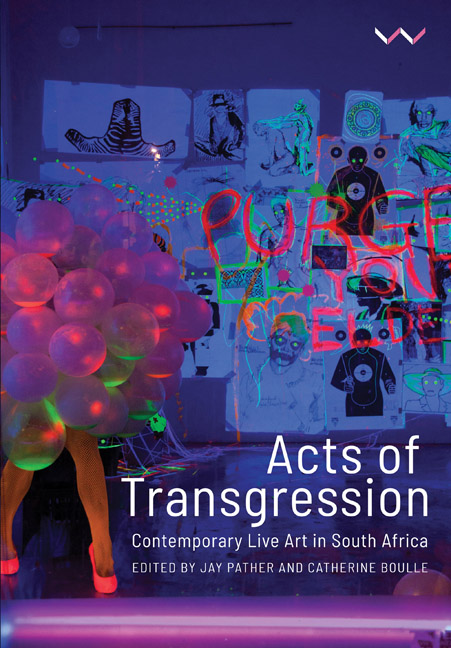Book contents
- Frontmatter
- Contents
- Acknowledgements
- Introduction
- PART ONE LIVE ART IN A TIME OF CRISIS
- PART TWO LOSS, LANGUAGE AND EMBODIMENT
- PART THREE RETHINKING THE ARCHIVE, REINTERPRETING GESTURE
- 9 don't get it twisted: queer performativity and the emptying out of gesture
- 10 Performing the Queer Archive: Strategies of Self-Styling on Instagram
- 11 Effigy in the Archive: Ritualising Performance and the Dead in Contemporary South African Live Art Practice
- PART FOUR SUPPRESSED HISTORIES AND SPECULATIVE FUTURES
- Contributors
- List of Illustrations
- Index
9 - don't get it twisted: queer performativity and the emptying out of gesture
from PART THREE - RETHINKING THE ARCHIVE, REINTERPRETING GESTURE
Published online by Cambridge University Press: 30 May 2019
- Frontmatter
- Contents
- Acknowledgements
- Introduction
- PART ONE LIVE ART IN A TIME OF CRISIS
- PART TWO LOSS, LANGUAGE AND EMBODIMENT
- PART THREE RETHINKING THE ARCHIVE, REINTERPRETING GESTURE
- 9 don't get it twisted: queer performativity and the emptying out of gesture
- 10 Performing the Queer Archive: Strategies of Self-Styling on Instagram
- 11 Effigy in the Archive: Ritualising Performance and the Dead in Contemporary South African Live Art Practice
- PART FOUR SUPPRESSED HISTORIES AND SPECULATIVE FUTURES
- Contributors
- List of Illustrations
- Index
Summary
The process of disidentification scrambles and reconstructs the encoded message of a cultural text … and recircuits its workings to account for, include and empower minority identities and identifications.
José Esteban Muñoz, Disidentifications: Queers of Color and the Performance of PoliticsAt an intersection in the Johannesburg inner city, a runner dressed in spandex bends down and enacts a series of provocative, erotic dance movements, as if on a nightclub stage. Inside a Pentecostal church near my studio, where I write this text, I have witnessed the exorcism of female congregants, their bodies convulsing while they speak in tongues, violently pulled and pushed by male priests, sometimes held by their hair. On Jeppe Street, transgender shop singers beckon to passersby to enter retail stores, hailing them in a register between song and speech on bassdistorted sound systems.
Where does a performance end and the self begin? How do these everyday gestures embody our visible selves, inscribing our identities within the symbolic structures that determine and set limits to how we are named, the way we move and the way we look? These modes of everyday performativity are both ciphers of our social belonging and our placement in a scene of visibility: the conditions of being seen. We are placed by the gazes of those who see us, but also by those who fail to see us, who misread, misplace, or make us invisible. And I too am responsible for how I see, both as a white body out of place here in inner-city Johannesburg but also as the holder of the power of inscription within this text. Each of the descriptions above refers to a moment of witnessed performativity – a word, an action, a gesture – that, in its enactment, potentially produces meaning. These are gestures made to be seen/scene.
This chapter focuses on queer practitioners working in transmedial forms across platforms, from social media to the gallery to public space: FAKA (Fela Gucci and Desire Marea), Athi-Patra Ruga and Dean Hutton (in collaboration with Alberta Whittle). I propose a close reading of gesture within the works of these artists and in the relationship each work stages between the body and an environment. I relate this reading of gesture to concepts drawn from the work of Diana Taylor: ‘repertoire,’ ‘transfer’ and ‘scenario.’
- Type
- Chapter
- Information
- Acts of TransgressionContemporary Live Art in South Africa, pp. 193 - 218Publisher: Wits University PressPrint publication year: 2019



